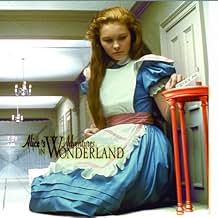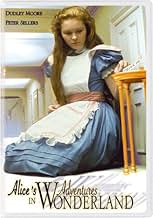PUNTUACIÓN EN IMDb
5,7/10
1,9 mil
TU PUNTUACIÓN
Alicia cae por la madriguera de un conejo y se adentra en un mágico mundo de ensueño poblado por personajes surrealistas y aventuras desconcertantes.Alicia cae por la madriguera de un conejo y se adentra en un mágico mundo de ensueño poblado por personajes surrealistas y aventuras desconcertantes.Alicia cae por la madriguera de un conejo y se adentra en un mágico mundo de ensueño poblado por personajes surrealistas y aventuras desconcertantes.
- Ganó 2 premios BAFTA
- 2 premios en total
Fred Cox
- Tweedledum
- (as Freddie Cox)
Argumento
¿Sabías que...?
- CuriosidadesThe Mock Turtle (Sir Michael Hordern), who says he is from what mock turtle soup is made, is a bull in a turtle's shell. This was because mock turtle soup (for those who couldn't afford to have real turtle soup) was generally made from veal.
- PifiasWhen Alice emerges from the pool of tears, seconds after being shoulder-deep in water she is completely dry.
Reseña destacada
Despite the widely held opinion that the material is unfilmable, Lewis Carroll's fantasy/nonsense classics Alice's Adventures in Wonderland (1865) and Through the Looking Glass and What Alice Found There (1871) have frequently been dramatized for films and television. Although few of these productions have successfully translated Carroll's verbal and intellectual experimentation into cinema, several are of superior quality and hold an under-appreciated place in the history of the fantastic film.
The initial rejection of Walt Disney's Alice in Wonderland (1951) must have seemed like a final and irrefutable validation of the dictum that any film based on this work of literature -- even one produced under the auspices of a major creative force -- is a doomed proposition. Yet, twenty-one years later, British producer Joseph Shaftel dared to attempt another major theatrical film version as a belated celebration of the centennial of one of England's greatest national literary treasures. This visually beautiful musical brings John Tenniel's famous illustrations to vivid life and is in general the best live-action film version of the classic. Approached in the proper spirit this literate film is a magical experience.
Carroll's characters are played by a distinguished all-star cast including Michael Crawford (the White Rabbit), Dudley Moore (the Dormouse), Ralph Richardson (the Caterpillar) and Peter Sellers (the March Hare), with Michael Hordern, Spike Milligan, Dennis Price and Flora Robson. Robert Helpmann (the wicked ChildCatcher of Chitty Chitty Bang Bang) played the Mad Hatter and also choreographed.
Teenage Fiona Fullerton was an ideal Alice for the film, bringing beauty, warmth and a soft, winsome quality to the neurotic (and difficult) character. Fullerton had previously been seen as one of the daughters of Nicholas and Alexandra in the 1971 film, which incidentally starred Michael Jayston, who appears here as "Lewis Carroll/Rev. Dodgson". As an adult Fullerton starred opposite Richard Harris in a major London revival of Camelot, and appeared as a gorgeous Bond Girl in A View to a Kill.
The film's cinematic distinction is its extraordinarily beautiful photography by Geoffrey Unsworth, B.S.C. (2001: A Space Odyssey; Cabaret), whose graceful images and fluid, balletic camera movements create a dream-like atmosphere. Equally striking is the imaginative production design by Michael Stringer (Fiddler on the Roof), who made the most of a moderate budget to create a spectacular artificial Wonderland plainly influenced by The Wizard of Oz (1939). As with Oz, elaborate character makeups and costumes carefully expose the personalities of the performers, unlike the stiff masks which stifle the actors in the 1933 Paramount version. And the film boasts some eye-popping (pre-CGI) special effects, with Alice's changes in size being impressively executed.
The haunting orchestral score by John Barry, then best known for The Lion in Winter and the James Bond films, finds the contrasting emotional mood underlying the cool cerebral surface. There is sprightly music enough but the score reflects a wistful, eerie and otherworldly quality evocative of Carroll's theme of loss of childhood. Original songs by Barry and Don Black (the "Born Free" team) include "Curiouser and Curiouser", which establishes the theme of the child awakening through bewilderment to new awareness, and "The Me I Never Knew", which poignantly resolves that theme.
The scenario, by director William Sterling, is very faithful Carroll's first "Alice" book, although a scene with the Cheshire Cat was cut prior to release, and Tweedledum and Tweedledee (from Through the Looking Glass) are included for good measure. Every major episode and character are retained, with dialogue taken verbatim from the text. New to the story is a prologue and epilogue dramatizing the famous Fourth of July river excursion undertaken by Lewis Carroll (in his real-life guise as the Rev. Charles L. Dodgson of Christ Church, Oxford), Rev. Duckworth, and the three Liddell Sisters, Lorina, Alice and Edith, in the course of which was told for the first time the story of Alice's Adventures Under Ground. This lovely sequence is imaginatively blended in the film with the tale itself.
Alice's Adventures in Wonderland was made at a time when the British film industry was rapidly dying. The film debuted in America at the Chinese Theater in Hollywood, was greeted with condescension by critics, and vanished into undeserved obscurity. Its value as a sincere and true reproduction of Carroll has not gone entirely unappreciated, however, and has been accorded a degree of respect in scholarly studies. Originally stunning in Todd-AO 35 widescreen, the film is badly in need of restoration and a decent DVD re-release.
The initial rejection of Walt Disney's Alice in Wonderland (1951) must have seemed like a final and irrefutable validation of the dictum that any film based on this work of literature -- even one produced under the auspices of a major creative force -- is a doomed proposition. Yet, twenty-one years later, British producer Joseph Shaftel dared to attempt another major theatrical film version as a belated celebration of the centennial of one of England's greatest national literary treasures. This visually beautiful musical brings John Tenniel's famous illustrations to vivid life and is in general the best live-action film version of the classic. Approached in the proper spirit this literate film is a magical experience.
Carroll's characters are played by a distinguished all-star cast including Michael Crawford (the White Rabbit), Dudley Moore (the Dormouse), Ralph Richardson (the Caterpillar) and Peter Sellers (the March Hare), with Michael Hordern, Spike Milligan, Dennis Price and Flora Robson. Robert Helpmann (the wicked ChildCatcher of Chitty Chitty Bang Bang) played the Mad Hatter and also choreographed.
Teenage Fiona Fullerton was an ideal Alice for the film, bringing beauty, warmth and a soft, winsome quality to the neurotic (and difficult) character. Fullerton had previously been seen as one of the daughters of Nicholas and Alexandra in the 1971 film, which incidentally starred Michael Jayston, who appears here as "Lewis Carroll/Rev. Dodgson". As an adult Fullerton starred opposite Richard Harris in a major London revival of Camelot, and appeared as a gorgeous Bond Girl in A View to a Kill.
The film's cinematic distinction is its extraordinarily beautiful photography by Geoffrey Unsworth, B.S.C. (2001: A Space Odyssey; Cabaret), whose graceful images and fluid, balletic camera movements create a dream-like atmosphere. Equally striking is the imaginative production design by Michael Stringer (Fiddler on the Roof), who made the most of a moderate budget to create a spectacular artificial Wonderland plainly influenced by The Wizard of Oz (1939). As with Oz, elaborate character makeups and costumes carefully expose the personalities of the performers, unlike the stiff masks which stifle the actors in the 1933 Paramount version. And the film boasts some eye-popping (pre-CGI) special effects, with Alice's changes in size being impressively executed.
The haunting orchestral score by John Barry, then best known for The Lion in Winter and the James Bond films, finds the contrasting emotional mood underlying the cool cerebral surface. There is sprightly music enough but the score reflects a wistful, eerie and otherworldly quality evocative of Carroll's theme of loss of childhood. Original songs by Barry and Don Black (the "Born Free" team) include "Curiouser and Curiouser", which establishes the theme of the child awakening through bewilderment to new awareness, and "The Me I Never Knew", which poignantly resolves that theme.
The scenario, by director William Sterling, is very faithful Carroll's first "Alice" book, although a scene with the Cheshire Cat was cut prior to release, and Tweedledum and Tweedledee (from Through the Looking Glass) are included for good measure. Every major episode and character are retained, with dialogue taken verbatim from the text. New to the story is a prologue and epilogue dramatizing the famous Fourth of July river excursion undertaken by Lewis Carroll (in his real-life guise as the Rev. Charles L. Dodgson of Christ Church, Oxford), Rev. Duckworth, and the three Liddell Sisters, Lorina, Alice and Edith, in the course of which was told for the first time the story of Alice's Adventures Under Ground. This lovely sequence is imaginatively blended in the film with the tale itself.
Alice's Adventures in Wonderland was made at a time when the British film industry was rapidly dying. The film debuted in America at the Chinese Theater in Hollywood, was greeted with condescension by critics, and vanished into undeserved obscurity. Its value as a sincere and true reproduction of Carroll has not gone entirely unappreciated, however, and has been accorded a degree of respect in scholarly studies. Originally stunning in Todd-AO 35 widescreen, the film is badly in need of restoration and a decent DVD re-release.
- Doctor_Mabuse
- 18 jul 2001
- Enlace permanente
Selecciones populares
Inicia sesión para calificar y añadir a tu lista para recibir recomendaciones personalizadas
- How long is Alice's Adventures in Wonderland?Con tecnología de Alexa
Detalles
- Fecha de lanzamiento
- País de origen
- Idioma
- Títulos en diferentes países
- Alice's Adventures in Wonderland
- Localizaciones del rodaje
- Empresa productora
- Ver más compañías en los créditos en IMDbPro
Taquilla
- Presupuesto
- 2.500.000 US$ (estimación)
- Duración1 hora 41 minutos
- Mezcla de sonido
- Relación de aspecto
- 2.35 : 1
Contribuir a esta página
Sugerir un cambio o añadir el contenido que falta

Principal laguna de datos
What is the English language plot outline for Las aventuras de Alicia (1972)?
Responde


































